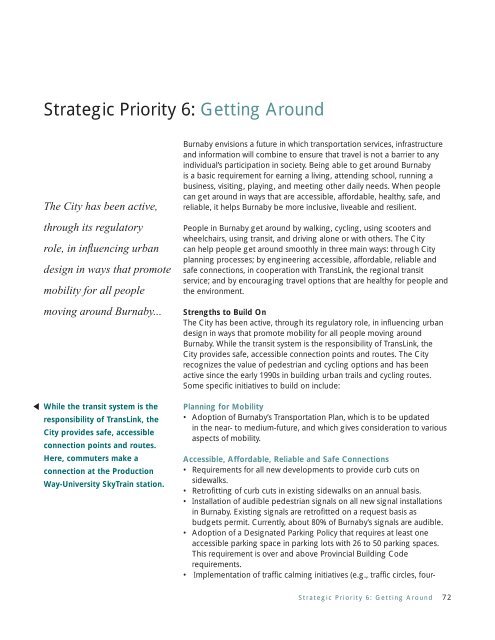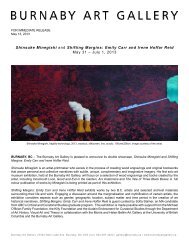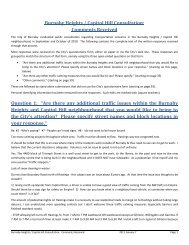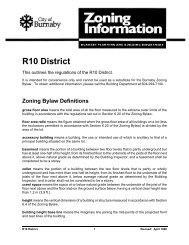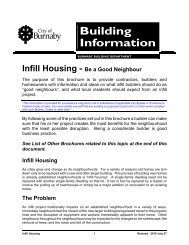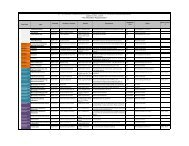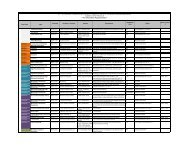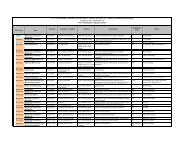Burnaby Social Sustainability Strategy - City of Burnaby
Burnaby Social Sustainability Strategy - City of Burnaby
Burnaby Social Sustainability Strategy - City of Burnaby
Create successful ePaper yourself
Turn your PDF publications into a flip-book with our unique Google optimized e-Paper software.
Strategic Priority 6: Getting Around<br />
The <strong>City</strong> has been active,<br />
through its regulatory<br />
role, in infl uencing urban<br />
design in ways that promote<br />
mobility for all people<br />
moving around <strong>Burnaby</strong>...<br />
While the transit system is the<br />
responsibility <strong>of</strong> TransLink, the<br />
<strong>City</strong> provides safe, accessible<br />
connection points and routes.<br />
Here, commuters make a<br />
connection at the Production<br />
Way-University SkyTrain station.<br />
<strong>Burnaby</strong> envisions a future in which transportation services, infrastructure<br />
and information will combine to ensure that travel is not a barrier to any<br />
individual’s participation in society. Being able to get around <strong>Burnaby</strong><br />
is a basic requirement for earning a living, attending school, running a<br />
business, visiting, playing, and meeting other daily needs. When people<br />
can get around in ways that are accessible, affordable, healthy, safe, and<br />
reliable, it helps <strong>Burnaby</strong> be more inclusive, liveable and resilient.<br />
People in <strong>Burnaby</strong> get around by walking, cycling, using scooters and<br />
wheelchairs, using transit, and driving alone or with others. The <strong>City</strong><br />
can help people get around smoothly in three main ways: through <strong>City</strong><br />
planning processes; by engineering accessible, affordable, reliable and<br />
safe connections, in cooperation with TransLink, the regional transit<br />
service; and by encouraging travel options that are healthy for people and<br />
the environment.<br />
Strengths to Build On<br />
The <strong>City</strong> has been active, through its regulatory role, in influencing urban<br />
design in ways that promote mobility for all people moving around<br />
<strong>Burnaby</strong>. While the transit system is the responsibility <strong>of</strong> TransLink, the<br />
<strong>City</strong> provides safe, accessible connection points and routes. The <strong>City</strong><br />
recognizes the value <strong>of</strong> pedestrian and cycling options and has been<br />
active since the early 1990s in building urban trails and cycling routes.<br />
Some specific initiatives to build on include:<br />
Planning for Mobility<br />
• Adoption <strong>of</strong> <strong>Burnaby</strong>’s Transportation Plan, which is to be updated<br />
in the near- to medium-future, and which gives consideration to various<br />
aspects <strong>of</strong> mobility.<br />
Accessible, Affordable, Reliable and Safe Connections<br />
• Requirements for all new developments to provide curb cuts on<br />
sidewalks.<br />
• Retr<strong>of</strong>itting <strong>of</strong> curb cuts in existing sidewalks on an annual basis.<br />
• Installation <strong>of</strong> audible pedestrian signals on all new signal installations<br />
in <strong>Burnaby</strong>. Existing signals are retr<strong>of</strong>itted on a request basis as<br />
budgets permit. Currently, about 80% <strong>of</strong> <strong>Burnaby</strong>’s signals are audible.<br />
• Adoption <strong>of</strong> a Designated Parking Policy that requires at least one<br />
accessible parking space in parking lots with 26 to 50 parking spaces.<br />
This requirement is over and above Provincial Building Code<br />
requirements.<br />
• Implementation <strong>of</strong> traffic calming initiatives (e.g., traffic circles, four-<br />
Strategic Priority 6: Getting Around 72


